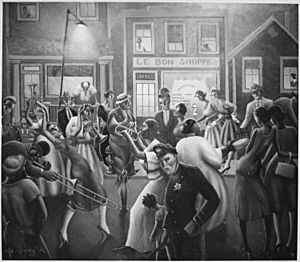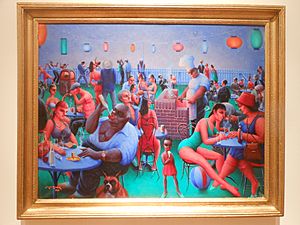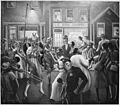Archibald Motley facts for kids
Quick facts for kids
Archibald John Motley, Jr.
|
|
|---|---|

Self Portrait (1920)
|
|
| Born | October 7, 1891 New Orleans, Louisiana, U.S.
|
| Died | January 16, 1981 (aged 89) Chicago, Illinois, U.S.
|
| Education | School of the Art Institute of Chicago |
| Known for | Painting |
| Movement | Harlem Renaissance, Chicago Black Renaissance |
Archibald John Motley, Jr. (October 7, 1891 – January 16, 1981) was an American artist. He is famous for his colorful paintings of African-American life. He studied at the School of the Art Institute of Chicago.
Motley's art often showed the experiences of African Americans in Chicago during the 1920s and 1930s. He was an important part of the Harlem Renaissance. This was a time when African-American art, music, and writing became very popular. In Chicago, this movement was called the Chicago Black Renaissance.
During this time, many Black artists wanted to create positive images of Black people. A writer named Alain Locke called this the "New Negro" idea. Motley's art helped show the many sides of Black culture. He was of mixed race himself. This made him think a lot about identity. His paintings often explored these complex ideas.
Contents
Early Life and Education
Archibald Motley, Jr. was born in New Orleans, Louisiana. His family moved to Chicago in 1894. His father worked for the railroad. As a boy, Motley had many jobs to help his family.
His grandmother, who had been a slave, lived with them. She shared stories about her life. Motley listened carefully to her memories. He learned about the past from her.
During World War I, Motley traveled across the country with his father. He saw many places like San Francisco and Philadelphia. These trips showed him different kinds of prejudice. Once, in Atlanta, Georgia, he was told off for standing in the front of a streetcar. This made him very angry.
Motley spent most of his life in Chicago. He lived in a mostly white neighborhood. He went to mostly white schools. He turned down a scholarship for architecture. Instead, he chose to study art.
He attended the School of the Art Institute of Chicago. He learned traditional painting styles there. He graduated in 1918. Motley kept his modern, jazz-inspired paintings a secret for a while.
Studying in France
In 1929, Motley won a Guggenheim Fellowship. This allowed him to study art in France for a year. While many artists looked to Africa for ideas, Motley found inspiration in European art. He visited the Louvre museum.
He admired the works of old masters like Rembrandt. Motley used these classic styles in his own art. He painted Black people, especially Black women, in ways that showed their beauty and strength. He wanted to break away from old, harmful stereotypes. He used his art skills to show the true individuality of Black people.
Career
When Motley first started, he wanted to paint only portraits. After art school in 1918, he decided to focus on Black subjects. He hoped his art would help ease racial tensions. In 1919, race riots in Chicago kept his family stuck at home. This made him even more aware of racial divides. He wanted to use his art to help the Black community.
Motley became successful early on. In 1927, his painting Mending Socks was very popular. It was shown at the Newark Museum. In 1928, he won the Harmon Foundation award. He was the first African American to have his own art show in New York City. He sold most of his paintings there. He was also the first Black artist to have a portrait of a Black person shown at the Art Institute of Chicago.
In the 1930s, Motley's style changed. He started painting urban Black scenes. He used a more modern style. These paintings showed real Black communities. They were different from his earlier, more traditional portraits.
The federal Works Progress Administration hired Motley in the 1930s. He painted murals showing African-American history. Some of these are in Evanston, Illinois. After his wife died in 1948, Motley faced tough times. He even painted shower curtains for a while. In the 1950s, he visited Mexico. He began painting Mexican life and landscapes.
Skin Tone and Identity

Motley grew up in a mixed neighborhood in Chicago. He didn't spend much time with other Black people. He was light-skinned and had a mixed background. He was part African, Native American, and European. This made him feel like an outsider at times. He struggled with his own racial identity.
Motley's art showed the many different skin tones within the Black community. He wanted to show that Black people are not all the same. He used different shades to give meaning to each person.
In the 1920s and 1930s, Motley painted a series of portraits. He focused on women of mixed racial backgrounds. He used old terms like "octoroon" (one-eighth Black) and "mulatto" (half Black) in his titles. He did this to show how society used these labels. He wanted to challenge the idea that all Black people were alike. His portraits celebrated the diversity of skin tones. They showed that these differences influenced people's lives.
Motley wanted to educate both Black and white audiences. He hoped Black people would appreciate their own identity. For white audiences, he wanted to end stereotypes. He showed the beauty and achievements of African Americans. His art showed the "contemporary black experience." He carefully painted the small differences between people.
In an interview, Motley explained his goal: "They're not all the same color... I try to give each one of them character as individuals." He wanted people to see each person as unique. He hoped white viewers would not group all African Americans together. He wanted them to get to know each person as an individual. His art helped show that Black people are part of a larger American culture.
Motley often painted for white collectors. He showed them a part of the Black community they might not have seen. His art helped broaden how people saw the Black experience.
Works and Jazz Culture
Motley's night scenes and crowd paintings are very popular. They were greatly influenced by jazz culture. He showed a lively, urban Black culture. This was very different from the old, simple images of Black people from the South. It's important to know that Motley himself was part of Chicago's wealthy Black community. He married a white woman and lived in a white neighborhood. He was an observer of the urban experience he painted.
Bronzeville at Night
Motley often painted Chicago's Bronzeville neighborhood. This area was a safe place for Black people moving from the South. Bronzeville at Night is one of his famous works. It shows African Americans enjoying city life. Motley captures many small interactions. He also shows the big picture of the lively street.
This painting, like others, doesn't have one main story. You see different people doing different things. A man looks serious. Another throws his arms up happily. A couple talks. Motley lets the viewer connect with the people and places in his art.
Stomp
In Stomp, Motley painted a busy cabaret scene. It shows the exciting urban Black culture. You can feel the energy in the painting. A woman dances with her hands up. A couple holds hands. A pianist watches the dancers. Both Black and white couples dance together. Motley wanted to show people mixing. He hoped to challenge ideas of segregation.
Some people say Motley's figures look like old minstrel characters. But Motley did not mean to stereotype. He wanted his crowd scenes to appeal to everyone. He aimed to show African-American progress and city life.
Octoroon Girl
The Octoroon Girl shows a woman who is one-eighth Black. She is graceful and has light skin. She sits on a sofa in a nice dress. She looks directly at the viewer with a calm gaze. Her clothes and the background show she is from a higher class. Her confident pose and elegant hands show her style. Motley used these details to show how Black people could fit into white beauty standards.
Motley was one of the few artists in the 1920s who showed African Americans positively. The Octoroon Girl is an example of this. It shows a middle-class African-American woman. Motley wanted her to be a symbol of social and economic progress.
In his paintings, Motley often made "octoroon" women look similar to white women. He gave them signs of wealth and European features. He wanted white viewers to see beyond her race. He wanted them to see her dignity and poise. He aimed to break down stereotypes.
The Mulatress
In his portrait The Mulatress (1924), Motley shows a "mulatto" woman. She is elegant and poised, like the "octoroon girl." She wears jewelry and sits in a relaxed way. But her face also shows some tension. Motley wanted to show the complex feelings of someone with mixed identity. He himself understood this feeling of being "caught in the middle." This painting explores the social impact of racial identity.
Motley used sharp angles and dark contrasts in her face. This suggested she was emotional or defiant. While this gave her personality, some might say it played into stereotypes of Black women. Motley was one of the few artists who painted African-American models with such detail. He treated these portraits like a study of different racial shades.
The difference between the girl's couch and the mulatress's wooden chair also shows class differences. Motley used these details to highlight social status.
Nightlife
In this period, Motley developed his unique style. He used contrasting lights and darks. He used strong patterns and a main color. He also created characters who appeared often in his paintings. These figures were often close together. Nightlife, at the Art Institute of Chicago, shows a busy nightclub. People are dancing, sitting at tables, and drinking. The whole painting glows with a warm, reddish light. You can feel the music's rhythm in the dancers' movements. They seem to be doing the popular Lindy Hop.
In an interview, Motley talked about fighting racism with paintings like Nightlife: "Racism is the first thing that they have got to get out of their heads... That means nothing to an artist. We're all human beings." He believed that racism should be forgotten. He said that once racism is gone, people can focus on enjoying life. In Nightlife, the club-goers seem to have forgotten racism. They are having a fun night out with jazz music and dancing. Motley shows them happily with warm colors and inviting body language.
Death
Motley died in Chicago on January 16, 1981.
Personal Life
Motley married his high school girlfriend, Edith Granzo, in 1924. Her German immigrant parents did not approve of their marriage. They disowned her because of it.
His nephew, Willard Motley, was a famous writer. He wrote the 1947 novel Knock on Any Door.
Motley was Catholic.
Recognition and Awards
- Frank G. Logan prize for the painting "A Mulattress" (1925).
- Joseph N. Eisendrath Award from the Art Institute of Chicago for the painting "Syncopation" (1925).
- Recipient Guggenheim Fellowship to study in Paris (1929–30).
- Harmon Foundation Award for art (1928).
- Received an honorary doctorate from the School of the Art Institute (1980).
- Honored by President Jimmy Carter at the White House (1980).
Retrospective Exhibition
Archibald Motley: Jazz Age Modernist was a special art show. It was the first big show of his paintings in 20 years. It opened in 2014 at the Nasher Museum of Art in North Carolina. The exhibition then traveled to other museums. These included the Amon Carter Museum of American Art in Texas, the Los Angeles County Museum of Art, the Chicago Cultural Center, and The Whitney Museum of American Art in New York.
Images for kids





